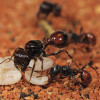Scientists may have solved the problem of how to keep donated organs fresh, by building the mirror image of one of nature's own antifreeze molecules. 
Writing in this month's Journal of the American Chemical Society, University of Chicago researcher Brad Pentelute and his colleagues describe how they painstakingly assembled an artificial version of a natural antifreeze protein made by the Canadian snowflea. These creatures live in the Arctic and can tolerate very low temperatures without icing up because they produce high levels of this molecule, which locks onto ice crystals when they try to form, interfering with their growth. These proteins could therefore be very useful in enabling donor organs to be kept at much lower temperatures without harm. The team started by making a replica of the snowflea's own antifreeze molecule by chemically linking together the amino acid building blocks in the correct sequence. The result worked beautifully and prevented a test solution from freezing.
Next they tried something extremely cunning. They rebuilt the molecule, but this time in its mirror image. This is possible because amino acids come in two forms, right and left handed, rather like gloves. For some reason nature uses only the "left" handed form, leaving the right handed form redundant. But chemicals made in this right handed shape can work equally well, which is what the team found, but they aren't easily broken down inside the body because they are totally the wrong shape to fit our left-handed enzymes. Consequently, the right handed form of this antifreeze protein can work extremely well, but it's effectively invisible to the immune system and also to the enzymes that would normally break it down, meaning that it could work for much longer.
This would allow organs to be kept colder for longer, increasing the chances of a successful transplant, and also reduce the risk of provoking an immune response to the antifreeze molecule in the recipient.










Comments
Add a comment